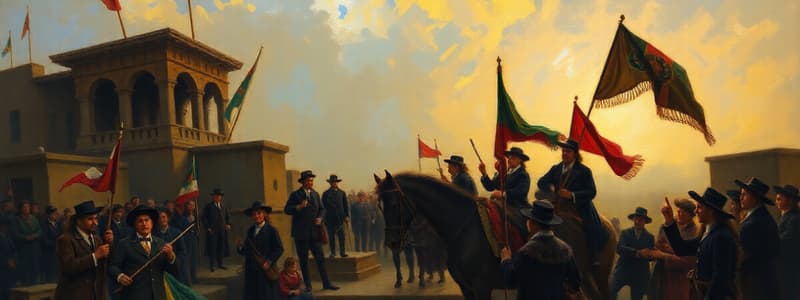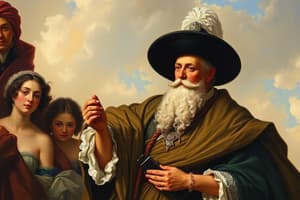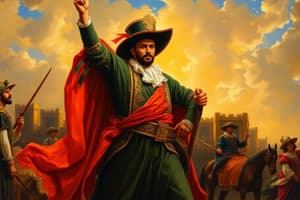Podcast
Questions and Answers
Miguel Hidalgo y Costilla's father served as a resident manager on the Hacienda de San Diego Corralejo.
Miguel Hidalgo y Costilla's father served as a resident manager on the Hacienda de San Diego Corralejo.
True (A)
Where did Miguel Hidalgo and his brother Jose Joaquin initially enroll in school?
Where did Miguel Hidalgo and his brother Jose Joaquin initially enroll in school?
- Hacienda de San Diego Corralejo
- Royal and Pontifical University
- Colegio of San Nicolas Obispo
- Colegio of San Prandsco Javier (correct)
What event led to the disruption of Miguel Hidalgo and his brother's studies at the Jesuit Colegio?
What event led to the disruption of Miguel Hidalgo and his brother's studies at the Jesuit Colegio?
The expulsion of the Jesuits from Spain and Spanish possessions in the New World by King Charles III
Miguel Hidalgo received his bachelor's degree in ____.
Miguel Hidalgo received his bachelor's degree in ____.
Match the following individuals with their descriptions:
Match the following individuals with their descriptions:
Who accepted the curacy of the parish of Dolores in 1803?
Who accepted the curacy of the parish of Dolores in 1803?
Hidalgo was known for his strict spiritual guidance over his parishioners.
Hidalgo was known for his strict spiritual guidance over his parishioners.
What kind of industries did Hidalgo introduce in Dolores?
What kind of industries did Hidalgo introduce in Dolores?
Hidalgo, a priest, referred to the Spanish king as a __________.
Hidalgo, a priest, referred to the Spanish king as a __________.
Match the individuals with their roles in the independence movements:
Match the individuals with their roles in the independence movements:
What was one of Hidalgo's main focuses in Dolores?
What was one of Hidalgo's main focuses in Dolores?
Many women played a role in planning activities and supporting the independence movement.
Many women played a role in planning activities and supporting the independence movement.
Who were the friends Hidalgo was introduced to by Allende?
Who were the friends Hidalgo was introduced to by Allende?
In 1800, Hidalgo was hailed before the __________.
In 1800, Hidalgo was hailed before the __________.
What type of meetings did Hidalgo and his group organize?
What type of meetings did Hidalgo and his group organize?
Flashcards
Miguel Hidalgo y Costilla's Early Life
Miguel Hidalgo y Costilla's Early Life
Miguel Hidalgo y Costilla, a priest who played a key role in the Mexican War of Independence, was born into a moderately wealthy family and spent his early years on the Hacienda de San Diego Corralejo in Guanajuato.
Hidalgo's Jesuit Education
Hidalgo's Jesuit Education
Hidalgo and his brother, Jose Joaquin, were sent to Valladolid (now Morelia) to study at the Jesuit Colegio of San Francisco Javier. The brothers were only two years into their studies when the Jesuits were expelled from Spain and its colonies, forcing them to move to the Colegio of San Nicolas Obispo.
Hidalgo's Academic Success
Hidalgo's Academic Success
Hidalgo excelled at his studies, focusing on rhetoric, Latin, and theology. He also learned Indian languages, showing a deep interest in his country's diverse population.
Hidalgo's Ordination
Hidalgo's Ordination
Signup and view all the flashcards
Hidalgo's Life as a Priest
Hidalgo's Life as a Priest
Signup and view all the flashcards
Who was Miguel Hidalgo?
Who was Miguel Hidalgo?
Signup and view all the flashcards
What were Hidalgo's controversial views?
What were Hidalgo's controversial views?
Signup and view all the flashcards
How did Hidalgo's life change after being investigated by the Inquisition?
How did Hidalgo's life change after being investigated by the Inquisition?
Signup and view all the flashcards
What industries did Hidalgo introduce in Dolores?
What industries did Hidalgo introduce in Dolores?
Signup and view all the flashcards
What were Hidalgo's intellectual pursuits?
What were Hidalgo's intellectual pursuits?
Signup and view all the flashcards
Who was Ignacio Allende and what role did he play in Hidalgo's life?
Who was Ignacio Allende and what role did he play in Hidalgo's life?
Signup and view all the flashcards
Who were some of the revolutionaries Hidalgo met through Allende?
Who were some of the revolutionaries Hidalgo met through Allende?
Signup and view all the flashcards
Who was Josefa Ortiz de Dominguez?
Who was Josefa Ortiz de Dominguez?
Signup and view all the flashcards
What role did women play in the Mexican War of Independence?
What role did women play in the Mexican War of Independence?
Signup and view all the flashcards
What were 'literary clubs' and why were they important?
What were 'literary clubs' and why were they important?
Signup and view all the flashcards
Study Notes
The Wars for Independence: Hidalgo and Early Success
- Hidalgo was born in 1753 to a criollo family in Guanajuato.
- He spent his early years on a hacienda and studied at Jesuit and diocesan colleges in Valladolid.
- Hidalgo earned a bachelor's degree in 1774 and became a priest in 1778.
- He taught at the Colegio of San Nicolás Obispo and eventually became the rector.
- Hidalgo faced scrutiny from the Inquisition due to unorthodox views and suspected deviations from orthodoxy.
- In 1803, Hidalgo became the curate of Dolores in Guanajuato.
- He prioritized improving the economic lives of his parishioners, introducing new industries like tile making.
- A group of revolutionaries, including Hidalgo, Allende, and Domínguez, formed a "literary club" to discuss reforms to local economies.
- The group planned an uprising for December 8, 1810, aiming for Mexican independence.
- Marino Galván, a postal clerk, leaked the planned revolt, alerting the Spanish authorities.
The Grito de Dolores
- On September 16, 1810, Hidalgo rang the church bells, calling his parishioners to mass and announcing the revolt.
- He addressed his parishioners and urged them to fight for independence, inspiring the Indians and mestizos.
- This event is known as the Grito de Dolores (Cry of Dolores).
- Hidalgo's force, consisting of poorly armed Indians and mestizos, captured San Miguel.
- Many Spanish citizens were killed in Guanajuato.
- The rebels moved toward Mexico City, facing strong opposition.
- Hidalgo's army gained support from various groups, including indigenous people and mestizos.
Hidalgo's Capture and Death
- Hidalgo's forces faced heavy losses in battles, including those at Las Cruces, and began to retreat, losing many troops.
- Hidalgo and Allende were caught and executed in 1811.
- Hidalgo's execution was intended as a warning to potential rebels.
- His execution was carried out following a trial by the Inquisition.
- His head was placed on display in Guanajuato.
Morelos and the Rebellion's Continuation
- After Hidalgo's death, José María Morelos took leadership of the independence movement.
- Morelos formulated a plan of action for the revolutionaries.
- Morelos called for a congress to meet in Chilpancingo, to discuss plans for the nation.
- The congress formalized independence and outlined a new constitution.
- Morelos' forces faced numerous setbacks and were eventually defeated.
- He was captured and executed in 1815.
The Aftermath and Guerrilla Warfare
- The independence movement continued through guerrilla warfare, employing hit-and-run tactics.
- Small bands of insurgents often dominated rural areas.
- Spanish attempts at counterinsurgency proved difficult.
- Several leaders, including Guadalupe Victoria and Vicente Guerrero, emerged.
The Plan de Iguala and Iturbide's Role
- Agustín de Iturbide, a former royalist officer, formed the Plan de Iguala.
- This plan sought an amicable resolution to the conflict.
- The proposed plan included the abolition of caste systems, universal male suffrage, and religious freedom.
- It also offered the Mexican throne to a suitable European prince, or, in its absence, a Mexican.
- Iturbide became a leader, uniting conservative and liberal forces.
- A treaty was signed, recognizing Mexican independence.
Studying That Suits You
Use AI to generate personalized quizzes and flashcards to suit your learning preferences.




